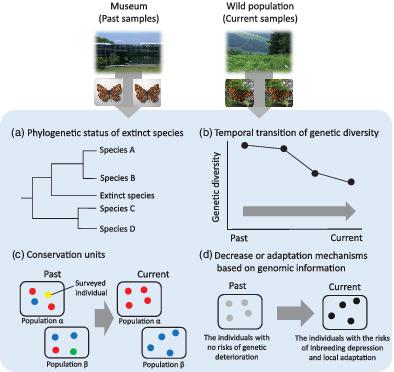当前位置:
X-MOL 学术
›
Ecol. Res.
›
论文详情
Our official English website, www.x-mol.net, welcomes your feedback! (Note: you will need to create a separate account there.)
Museum specimens: An overlooked and valuable material for conservation genetics
Ecological Research ( IF 2 ) Pub Date : 2020-10-20 , DOI: 10.1111/1440-1703.12181 Naoyuki Nakahama 1, 2
Ecological Research ( IF 2 ) Pub Date : 2020-10-20 , DOI: 10.1111/1440-1703.12181 Naoyuki Nakahama 1, 2
Affiliation

|
Museum specimens include genetic information from when they were collected. This historical information, which is very difficult to ascertain from samples collected currently, could be a valuable material for use in conservation genetics. However, the genetic analysis of museum specimens is technically difficult because of DNA fragmentation and the deamination of cytosine to uracil. In recent years, various methods have been developed for the genetic analysis of museum specimens, such as data analysis techniques including next‐generation sequencing. The development of approaches that extract historical genetic information from museum specimens is expected to provide a new perspective on conservation genetics. This review focuses on the availability of museum specimens as genetic resources for conservation genetics. Some case studies are introduced, and perspectives on the future utility of conservation genetic studies using museum specimens are discussed. Moreover, recommended genetic analysis methods and important points for the usage of museum specimens are presented. This review provides a strong case for increasing the usage of museum specimens in conservation genetics studies in the future.
中文翻译:

博物馆标本:保护遗传学的一种被忽视且有价值的材料
博物馆标本包括收集时的遗传信息。从当前收集的样本中很难确定这一历史信息,这可能是用于保存遗传学的有价值的材料。但是,由于DNA片段化以及胞嘧啶脱氨成尿嘧啶,博物馆标本的遗传分析在技术上很困难。近年来,已开发出多种方法用于博物馆标本的遗传分析,例如包括下一代测序在内的数据分析技术。从博物馆标本中提取历史遗传信息的方法的发展有望为保护遗传学提供新的视角。这项审查侧重于博物馆标本作为保护遗传学的遗传资源的可用性。介绍了一些案例研究,讨论了使用博物馆标本进行保护性遗传研究的未来实用性的观点。此外,介绍了推荐的遗传分析方法和博物馆标本使用的重点。这篇综述为将来在保护遗传学研究中增加博物馆标本的使用提供了有力的依据。
更新日期:2020-10-20
中文翻译:

博物馆标本:保护遗传学的一种被忽视且有价值的材料
博物馆标本包括收集时的遗传信息。从当前收集的样本中很难确定这一历史信息,这可能是用于保存遗传学的有价值的材料。但是,由于DNA片段化以及胞嘧啶脱氨成尿嘧啶,博物馆标本的遗传分析在技术上很困难。近年来,已开发出多种方法用于博物馆标本的遗传分析,例如包括下一代测序在内的数据分析技术。从博物馆标本中提取历史遗传信息的方法的发展有望为保护遗传学提供新的视角。这项审查侧重于博物馆标本作为保护遗传学的遗传资源的可用性。介绍了一些案例研究,讨论了使用博物馆标本进行保护性遗传研究的未来实用性的观点。此外,介绍了推荐的遗传分析方法和博物馆标本使用的重点。这篇综述为将来在保护遗传学研究中增加博物馆标本的使用提供了有力的依据。



























 京公网安备 11010802027423号
京公网安备 11010802027423号